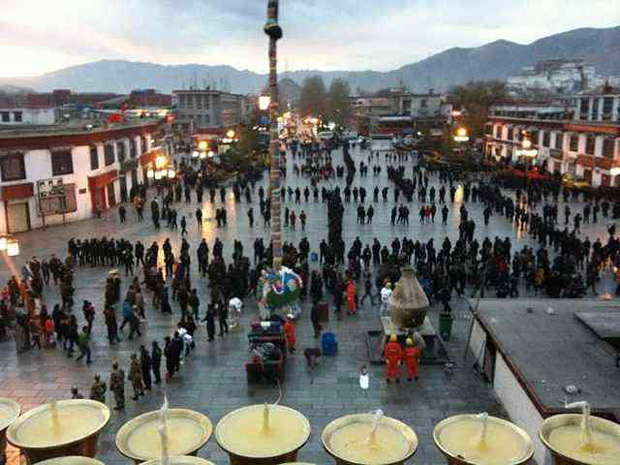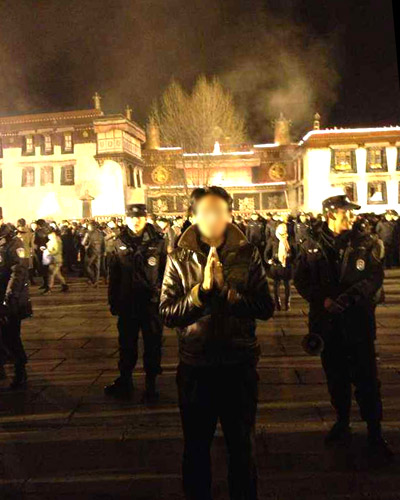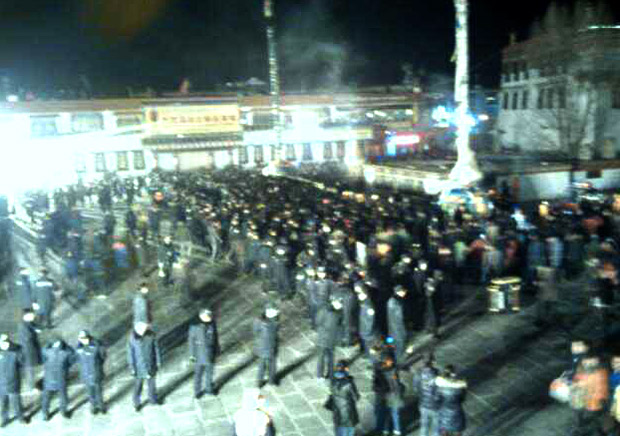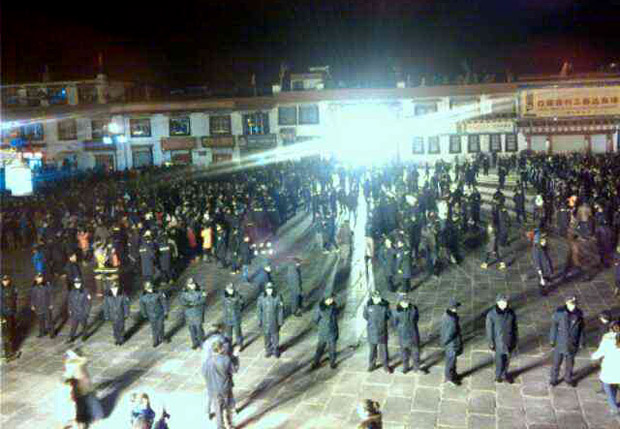 Farmer Pema Dorjee, 23, who self-immolated on December 8 (2012).  Farmer Pema Dorjee, 23, who self-immolated on December 8 (2012). |
Three Tibetans have self-immolated and died on December 8 and 9 – the time of an important Buddhist anniversary associated with the Dalai Lama.
Two of the self-immolations, 24 year old monk Kunchok Pelgye in Dzoege, Ngaba, and 23 year old Pema Dorjee in Luchu, took place near the main assembly halls of monasteries. Seventeen year old Wangchen Kyi set fire to herself in a nomadic area of Tsekhog, Qinghai, and may have done so intentionally because she believed that her corpse would not be returned to her family if she had self-immolated outside a government building.
This brings the total number of self-immolations in Tibet to 95.
Images obtained from Lhasa show troops and firemen massed outside the Jokhang temple, one of Tibet’s holiest sites, on Saturday, December 8, an important Buddhist anniversary that marks the passing of great teacher Tsongkhapa, founder of the Gelugpa (Yellow Hat) school of Buddhism, and is traditionally marked by prayers and lighting butter-lamps. The images show troops gathered outside the Jokhang in the Barkhor area of Lhasa, including troops in black uniforms, with some in camouflage uniform. In one image, firemen are visible beside one of the incense-burners and in another, a solitary Tibetan man stands to pray as troops stand guard behind him, facing outwards from the temple. [ Images posted below ]
Mary Beth Markey, President of the International Campaign for Tibet, said: “Today’s dramatic images from Lhasa show Tibetans undeterred from their religious devotions by armed intimidation and, significantly, links them in defiance with Tibetans across the plateau who are confronting Chinese authority by setting themselves on fire.”
An ICT report published today gives comprehensive analysis on the relation between the Tibetan self-immolations and Chinese policies in Tibet, and concludes that these developments represent a new political moment for Tibetans as they confront and challenge China on its repressive policies and failures in Tibet.
Self-immolation of Wangchen Kyi
Seventeen year old student Wangchen Kyi died after setting fire to herself at around 8 pm in the evening on December 9 in the Dokarmo nomadic area of Tsekhog (Chinese: Zeku) county in Malho (Chinese: Huangnan) Tibetan Autonomous Prefecture in Qinghai (the Tibetan area of Amdo. Wangchen Kyi called for the long life of the Dalai Lama and of the Tibetan people as she set herself ablaze, according to reports from exile Tibetans in contact with people in the area.
According to one Tibetan source, Wangchen Kyi had talked about her intention to self-immolate, saying that she wanted to do this in the grasslands rather than outside a government building in the town, for fear that her body would not be returned to her family if she chose the latter.
Wangchen Kyi was the middle child of three, and people who knew her said she always worked hard at her studies. Her body was cremated at around midnight, and monks and lay Tibetans gathered at the site to chant prayers.
According to Voice of America Tibetan services, the crowd was dispersed by two truckloads of armed police that arrived on the scene.
Self-immolation of Kunchok Pelgye
On December 8, the anniversary of Buddhist teacher Tsongkhapa’s passing, 24-year old monk Kunchok Pelgye set himself on fire outside the main assembly hall of the Taktsang Lhamo Kirti monastery in Dzoege, in Ngaba Tibetan and Qiang Autonomous Prefecture, Sichuan (the Tibetan area of Amdo).
Kunchok Pelgye joined his hands in prayer, and called for the Dalai Lama to live for 10,000 years, and for him to be allowed to return to Tibet. He also called for Kirti Rinpoche, the exiled head of the important and influential Kirti monastery in Ngaba where the self-immolations in Tibet began, to be allowed to return to Tibet. Kirti monastery is in Ngaba town, Ngaba (Chinese: Aba) county in Ngaba Tibetan and Qiang Autonomous Prefecture, while Kunchok Pelgye self-immolated in Dzoege county in the same prefecture. According to the same exile sources, Kunchok Pelgye also called for Tibetans inside Tibet and in exile to be reunited.
Kirti monks in exile told ICT: “As he self-immolated, monks present gathered around him in shock and began to recite a prayer that is usually said in Kirti Rinpoche’s honour. His remains were carried back to his room in the monastery, and the hundreds of monks present continued to chant prayers dedicated to him.”
Kunchok Pelgye had been a monk at the Dringwa Sumdo monastery in Dzoege (Chinese: Ruergai/ Zoige County) since he was a child, and in 2010 joined the larger monastery of Taktsang Lhamo – where he self-immolated – to study scripture. He joined the senior philosophy class.
The Chinese authorities have now placed Taktsang Lhamo Kirti monastery and surrounding villages under a security blockade, according to the Kirti monks in exile.
Self-immolation of Pema Dorjee in Luchu
Twenty-three year old farmer Pema Dorjee set fire to himself and died also on December 8, close to the main assembly hall of Shitsang Garser monastery in Luchu (Chinese: Luqu) in Gannan Tibetan Autonomous Prefecture, Gansu province.
Pema Dorjee lived around 30 kilometers from the monastery and had gone there to pray at the time of the anniversary of Tsongkhapa’s passing. At the time of his self-immolation there were many people at the monastery.
Pema Dorjee shouted that the Dalai Lama should be allowed to return to Tibet, and called for the unity of the Tibetan people. According to Tibetan exile sources, Pema Dorjee left his photos and identity card with his motorbike before his self-immolation. Graphic pictures were received from Tibet of Pema Dorjee’s self-immolation, as local people looked on.
Both the Dalai Lama and the Panchen Lama belong to the Gelugpa (Yellow Hat) order of Tibetan Buddhism, believed to be founded by the great teacher and scholar Tsongkhapa (1357-1419). Every year on the anniversary of Tsongkhapa’s death, Tibetans light butter lamps and chant scriptures in praise of him. There has traditionally been a particular focus on marking his passing at the Jokhang temple in Lhasa.
‘Storm in the Grasslands’: ICT report on self-immolations in Tibet and Chinese policy
A report published today by the International Campaign for Tibet titled ‘Storm in the Grasslands’, which is available for downloading, gives comprehensive analysis on the relation between the Tibetan self-immolations and Chinese policies in Tibet.
The report seeks to answer the questions:
- Who are the Tibetan self-immolators?
- Why are they burning themselves?
- What is their message?
- What has been the policy and security response from the Chinese party state?
These striking new images obtained from Lhasa show troops and firemen massed outside the Jokhang temple, one of Tibet’s holiest sites, on Saturday, December 8, an important Buddhist anniversary that marks the passing of great teacher Tsongkhapa, founder of the Gelugpa school of Buddhism, and is traditionally marked by prayers and lighting butter-lamps. The images show troops gathered outside the Jokhang in the Barkhor area of Lhasa, including troops in black uniforms, with some in camouflage uniform. In one image, firemen are visible beside one of the incense-burners.





